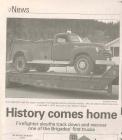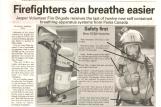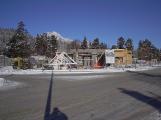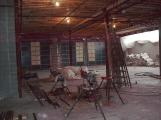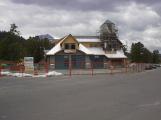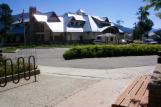147
Jasper Park Lodge loses the historical Outlook Cabin to a fire.9 November 2000
Jasper Park Lodge, Jasper National Park, Alberta, Canada
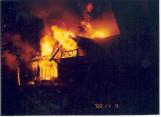
148
Don Patry: Jasper Park Volunteer Fire Brigade member"There's a couple of experiences that stand out in my mind that I'll probably carry with me for awhile. The first occurred shortly after I became a member of the JVFB. It was my first response to an MVA [motor vehicle accident] in which, unfortunately, there were fatalities involved. The feeling that went through me, I will never forget, as I was involved in the removal of the victim I recall my knee's shaking uncontrollably and a real sense of fear on approaching the vehicle to complete the extracation.
That experience (and I know it happens to many new members) is a difficult test of one's fortitude. One thinks that he will handle it without any problem, but the opposite occurs and fear can overtake you. Since then I try and share my experience with the new members as an assurance that big, strong men do get shakey knees!
The second experience that I recall was my first response to a "major fire." It was a very cold, early morning in November, when Outlook cabin at the Jasper Park Lodge burnt to the ground. I recall as we approached the JPL property in pump 2; we could see flames towering over top of the buildings from a long distance away. I had to really concentrate to control my excitement as we approached the scene. I recall the calmness of the officer on board (Marven Garford), which was very beneficial for the crew, as we were mostly newer members on the pumper.
At the scene, one of our duties was to deploy a 77mm attack line to the far side of the cabin to assist in basically a "surround and drown" tactic, as the cabin was far beyond saving and fully engulfed. I was the firefighter that was on the nozzle, sitting on the pressure loop (looped hose to sit on) basically putting lots of water on the cabin. I was situated slightly downhill of the cabin and was probably on the hose for close to 1 1/2 hours (it seemed a lot longer!). I believe it was in the -30C range and the water was flowing towards me on the ground.
After the fire was under control, and I was finally able to break, I stopped the water stream and attempted to stand up and couldn't move my legs. I fell back to the ground. I knew I'd be a little stiff from sitting on a hard hose for a couple of hours, but I didn't think I would be that bad! I fumbled around and finally got to my feet, all the time thinking, " I got to start hitting the gym." But as it turned out, it wasn't my lack of physical fitness that was causing my problems, but rather the fact that the water that had been rolling down the hill had been seeping into my turnout pants and freezing my pant legs; it was a good lesson learned!
150
"History comes home"(originally appeared in The Jasper Booster, Sept. 26, 2001)
by: Nathan Anderson
A two year search and recovery mission came to an end at the beginning of September for the Japser volunteer Fire Brigade. The Brigade brought home the second truck they ever used, an important piece of local history.
"We've been looking for it for about two years. It's an important bit of history that would have ended up as scrap metal," said Ron Stanko, chairman of the Fire Brigade's Historic Society [Stanko is currently the Deputy Fire Chief for Jasper volunteer Fire Brigade].
"It's still in reasonably good shape. We plan to totally restore it and use it for community events like parades or kids rides," he said.
The truck is now protected from the elements at the Trans Mountain Pipeline compound...
152
"Firefighters can breathe easier"(originally appeared in The Jasper Booster, August 22, 2001)
by Nathan Anderson
Members of the Jasper Volunteer Fire Brigade now have a full set of new self contained breathing apparatus gear, thanks to a purchase by Parks Canada. Over two years Parks purchased 12 sets of new breathing apparatus, with an extra air bottle per set, at a cost of about $65,000. The last four apparatus were received by the Fire Brigade at the beginning of August.
"The new SCBA's are lighter, hold more air, and have new safety features required by the NFPA. They are state of the art, the best and safest thing going," said Jasper Fire Chief Greg Van Tighem. The new breathing apparatus replace the Brigade's 15 year old former SCBA's, which were at the end of their usable lifespan, he added.
Upon delivery of the first several SCBA's, the manufacturer came to Jasper and trained firefighters in their use. Since that time the new units have been phased into use, vehicle by vehicle, according to Van Tighem.
Features of the new SCBA:
Mask Attatchement- new style is easier to attach.
Man Down Alarm- New safety feature sounds an alarm if a firefighter hasn't moved in 25-30 seconds.
Gauge- Besides a gauge on the regulator, a second gauge hangs on the firefighters' shoulder for an easier way to check his or her tank's capacity.
Back Plate- Lighter back plate also brings total weight of unit down.
New Bottle- Carbon/Fiberglass wrap makes bottle lighter, and able to hold more pounds per square inch of gas (PPSIG). They weigh about half what the Fire Brigade's former bottles did at 12.5 lbs., and hold 30 minutes of air as opposed to the 22 minutes of the former bottles.
Alarm Bell- When pressure in the tank is low and about five minutes of air remains, this alarm bell rings and gets louder as time goes on.
Straps- New strap system makes BA easier and faster to put on, very similar to a modern backpack, with a handy seatbelt attatchment on the front belly strap.
154
A New Home for Jasper Park Volunteer Fire BrigadeIn the mid-nineties, an I.A.O. report focused on the brigade's equipment and recommended that it acquire a new pumper truck, as the 1978 pumper truck was becoming increasingly unreliable. However, because the current Fire Hall had been recently designated as a Federal Heritage Building, another addition to accomodate any new equipment like an engine was out of the question. In order for Jasper Park Volunteer Fire Brigade to progress with the times, a new fire hall would be necessary.
The proposed Fire Hall would be known as the Jasper Emergency Services Building. The building would provide the brigade with more than enough space for volunteers and equipment. Also, it would provide space for ambulance services, accomodations for emergencies, volunteer shifts, and a large room for training or extra emergency space.
157
Serving the CommunityFire Chief, Greg Van Tighem, speaks of building up the strengths of the brigade and improving upon their achievements. A new emergency centre would be essential in providing the community of Jasper with a volunteer brigade who had the ability to help, adapt, and resolve any emergency situation in an effective manner.
The project proposal describes the centre as a "two-storey combined fire hall and ambulance facility for the municipality of Jasper and outlying areas. The propsed Jasper Emergency Services Building (JESB) will be able to house three ambulance vehicles, five fire fighting vehicles and the associated equipment and facilties required to deliver structural fire protection services and ambulance services to the community of Jasper."
The proposal included an environmental assessment report. This meant the proposed centre would be built with a conscious effort towards the environment and the physical impact of the structure within that environment. Along with the actual construction and the finished project, consideration to the environmental impact and wildlife habitat would be taken under advisement and handled sensitively and in accordance with Parks Canada.
Construction on JESB began on October 15, 2000 and the opening ceremony was held on July 24, 2002. The contract for construction was awarded to Reed Atwood Inc., a Calgary company, who gave the lowest bid at $2,644,600. The estimate included a base price of 2.5 million and the total cost would remain within the $3,000,000 budget alotted; including 1.6 million from Parks Canada.
Locally, the building was seen as a "landmark for Jasper." Another important inference was the new emergency centre as a "model of cooperation between the Municipality and Parks Canada." This was indeed true; the newly formed municipality of Jasper was gaining the confidence of Parks Canada and perhaps is to become an example of the future between National Parks Canada and the communities that inhabit them.
159
The Importance of FireFire is an important and dangerous element to living in Jasper National Park and outlying areas. Before Jasper National Park was developed forest fires occurred on a cyclical basis. Unfortunately, early settlements were often unprepared for the fire. In the early days of the park, fire was viewed as a preventable tragedy and when the Dominion Volunteer Fire Brigade was established its main goal was to supress all forest fires in order to protect the Government's investments and the settlements.
During the last few decades, ecologists and people involved in maintaining the Park have become more sensitive to the role played by fire within the park's ecosystem. Not only do forest fires promote re-growth and fertilization of the land; it also helps to maintain wildlife habitats and helps to prevent the over population of the forests. Forests that are too heavily treed or has a lot of dense, dead, undergrowth present a number of hazards; it robs the wildlife of its natural habitat and it provides extensive fuel for forest fires that are started by nature or accidently (thereby creating greater damage and danger).
Reports done in the past have suggested that the supression of forest fires in the past has played a major role in changing the natural landscape that is Jasper National Park today. Therefore, the prescribed burning program was implemented as a means of "reintroducing fire under tightly controlled conditions, to a landscape that has been deprived of natural fires for decades." The "tightly controlled conditions" include a fire guard on the North and West perimeter of Jasper townsite. The fireguard extends from the Pyramid Lake Road and runs along the Cabin Creek Road to the water reservoir and from there to the CNR tracks. The fireguard was started in 1984 and fully completed by 1992.
According to an Edmonton Journal article (April 16, 2000) "Jasper's long-term goal is to conduct a number of man made burns that will eventually produce conditions that will allow natural fires to take over without seriously threatening the commercial forest reserves outside the park or other regions within the National Park." Reintroducing natural forest fire to Jasper National Park is a huge undertaking that is still in progress. It is a task that has many components concerned with responsibility, safety, and providing people with precautionary measures that can be easily implemented.
160
FireSmartThe FireSmart program provides people with precautionary guidelines and steps that they can follow in order to make sure that their families and property is protected. According to the FireSmart manual 40% of all wildfires are caused by human activity. However, 60% of Alberta's wildfires are caused by lightening strikes. The FireSmart manual focuses on "reducing risks to home and community." The manual outlines three major areas that will aid in reducing the threat of and damage to property and people in the event of a wildfire.
The first 10 meters of space that surrounds the home is known as: the first priority zone. This space should be free of all combustible materials including vegetation: "Managing the space around your house and buildings is of prime importance." The second priority zone is considered to be ten to thirty meters out from the home. The main goal should be to "reduce and manage potential fuel sources so that combustion cannot be supported." And finally, the third priority zone "begins thirty meters from any structure and extends to a distance of 100 meters and beyond." This zone is probable the most extensive, but it is pivitol in reducing "the potential for a crowning fire" by maintaining the grounds and vegetation.
The structure and material out of which a building should be built is also a part of the FireSmart program. "Ensuring that designs and materials used to take fire safety and prevention into consideration." The program also suggests a need for people to have developed an emergency plan prior to the event of an emergency, as a precautionary measure, that may help prevent panic and save lives.
